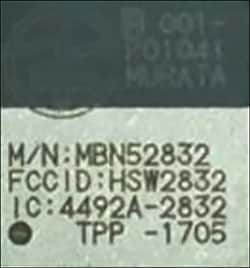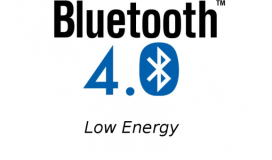Electronic components company Murata has released a fingernail-sized, low-power-consuming module for use in Internet of Things (IoT) devices that incorporates Bluetooth Low Energy (BLE) and Near Field Communication (NFC) technologies. The unit is designed for companies building IoT solutions for home or building automation, proximity services, health care or beacon-based systems.
Murata's miniaturized MBN52832 module measures 7.4 millimeters by 7 millimeters by 0.9 millimeter (0.29 inch by 0.27 inch by 0.04 inch). The component is designed to offer low power consumption and higher processor capabilities than its predecessors, the company reports, while including NFC and BLE functionalities.
Due to its small size and multiple data-transmission options, the module is a first for Murata, according to Yong Fang, the company's marketing manager. It features a Nordic ID-based BLE module, and may be the first product like it to be offered with Murata's high-volume manufacturing capabilities, he adds. The MBN52832 comes with a built-in ARM Cortex M4 core, with 64 kilobytes of RAM and 512 kilobytes of flash memory for data processing. It features an onboard BLE antenna and can accommodate an external NFC antenna.

Like many Murata products, Fang says, the new IoT component's development was customer-driven. Users of Murata products expressed a need for IoT-based components that offered the versatility of both BLE and NFC technologies. "This offers a good system for customers who want to build IoT solutions," he states. The Cortex M4 core, along with RAM and flash capability, make it a suitable basis for multiple solutions, the firm reports.
The device comes with a serial port; a port for temperature, humidity or light sensors; and the capacity for dimming or current control. "So from the designers' point of view," Fang states, "they can use it as a single component to add wireless functionality" and sensors.
The most common application for NFC, Fang says, is to enable users to put to sleep an IoT device built from the new Murata component, in order to conserve battery life. The device will typically be used without a power connection. For that reason, he adds, devices would rely solely on battery power, with the battery expected to last for one to three years.
"You would want to limit power consumption," Fang states. To put the module to sleep, a user would tap an NFC-enabled tag or a mobile phone against the device, thereby saving power as a result. For example, as someone were leaving or entering a building, he or she could tap the NFC device against the Murata-based technology and thus put it to sleep. The device can also go to sleep automatically at a preset time, and be woken up via an NFC reader tap.
NFC could also help to establish a BLE connection more directly, by eliminating the need for a new user to input a passcode to access or share BLE-based data. Two immediate applications for the device, Fang says, will be the development of lighting-control devices, such as light bulbs or lighting-control switches.
The BLE functionality will enable a device with the MBN52832 unit to transmit or receive beacon transmissions to or from a user's smartphone, in order to create a long read range connection to the Internet via that phone. Conversely, Fang notes, users could set up their own BLE-based gateway using a Wi-Fi or cellular connection to send BLE-based data, including sensor measurements and the device's unique ID, to a server at predetermined intervals.
Beyond smart buildings and homes, as well as agricultural settings, Fang predicts the new component will be used in medical devices such as blood pressure or glucose monitors that could collect sensor data and then transmit that information to a phone via BLE. NFC could be used to program a Web link for users—for instance, the device could link an individual's phone, via NFC or BLE, to a website where he or she could learn more information about a given product or appliance to which a smart device is attached.
The advent of BLE mesh technology, Fang says, makes that even more advantageous. Lighting control or other building-intelligence solutions could take advantage of a BLE mesh network, by allowing users to forward messages through a large building or space via the devices, thereby creating a location for tracking assets and controlling lighting.



